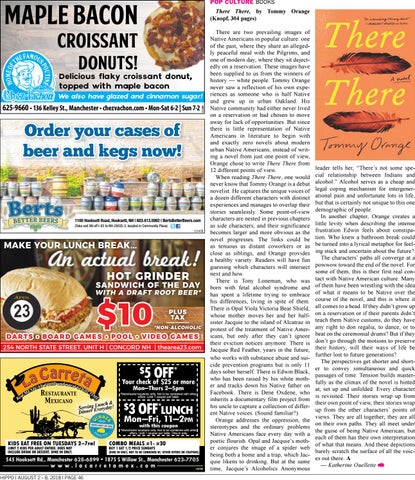MAPLE BACON
POP CULTURE BOOKS
There There, by Tommy Orange (Knopf, 304 pages)
CROISsANT DONUTS!
Delicious flaky croissant donut, topped with maple bacon We also have glazed and cinnamon sugar! 122368
625-9660 • 136 Kelley St., Manchester • chezvachon.com • Mon-Sat 6-2 | Sun 7-2
Order your cases of beer and kegs now!
1100 Hooksett Road, Hooksett, NH | 603.413.5992 | BertsBetterBeers.com (Take exit 9N off I-93 to NH-28/US-3, located in Community Plaza) 121470
MAKE YOUR LUNCH BREAK...
An actual break! HOT GRINDER
SANDWICH OF THE DAY
WITH A DRAFT ROOT BEER*
*NON-ALCOHOLIC
DARTS • BOARD GAMES • POOL • VIDEO GAMES
120851
$10
PLUS TAX
254 NORTH STATE STREET, UNIT H | CONCORD NH | thearea23.com
* 5 OFF Your check of $25 or more $
OD and a real
GO OD TI M E
Mon–Thurs 2–5pm
*Manchester locations only. Not to be combined with other offers. Limit 1 coupon per table
Lunch & Servinrg Everyday! Dinne
3 OFF*LUNCH
$
076978
al Re
O AN F XIC ME
Mon–Fri, 11–2pm with this coupon
*Manchester locations only. Not to be combined with other offers. Limit 1 coupon per table. Dine in only.
KIDS EAT FREE ON TUESDAYS 2–7pm!
LIMIT 2 KIDS PER ADULT ENTREE. DOES NOT INCLUDE DRINK OR DESSERT. DINE IN ONLY.
COMBO MEALS #1- #30
BUY 1 GET 1/2 PRICE SUNDAYS
(DINE IN ONLY, NOT TO BE COMBINED W/ OTHER OFFERS OR COUPONS)
545 Hooksett Rd., Manchester 628-6899 • 1875 S Willow St., Manchester 623-7705
www.lacar r etamex.com
HIPPO | AUGUST 2 - 8, 2018 | PAGE 46
120798
There are two prevailing images of Native Americans in popular culture: one of the past, where they share an allegedly peaceful meal with the Pilgrims, and one of modern day, where they sit dejectedly on a reservation. These images have been supplied to us from the winners of history — white people. Tommy Orange never saw a reflection of his own experiences as someone who is half Native and grew up in urban Oakland. His Native community had either never lived on a reservation or had chosen to move away for lack of opportunities. But since there is little representation of Native Americans in literature to begin with and exactly zero novels about modern urban Native Americans, instead of writing a novel from just one point of view, Orange chose to write There There from 12 different points of view. When reading There There, one would never know that Tommy Orange is a debut novelist. He captures the unique voices of a dozen different characters with distinct experiences and manages to overlap their stories seamlessly. Some point-of-view characters are nested in previous chapters as side characters, and their significance becomes larger and more obvious as the novel progresses. The links could be as tenuous as distant coworkers or as close as siblings, and Orange provides a healthy variety. Readers will have fun guessing which characters will intersect next and how. There is Tony Loneman, who was born with fetal alcohol syndrome and has spent a lifetime trying to embrace his differences, living in spite of them. There is Opal Viola Victoria Bear Shield, whose mother moves her and her halfsister Jacquie to the island of Alcatraz in protest of the treatment of Native Americans, but only after they can’t ignore their eviction notices anymore. There is Jacquie Red Feather, years in the future, who works with substance abuse and suicide prevention programs but is only 11 days sober herself. There is Edwin Black, who has been raised by his white mother and tracks down his Native father on Facebook. There is Dene Oxdene, who inherits a documentary film project from his uncle to capture a collection of different Native voices. (Sound familiar?) Orange addresses the oppression, the stereotypes and the ordinary problems Native Americans face every day with a poetic flourish. Opal and Jacquie’s mother conjures the image of a spider web being both a home and a trap, which Jacquie likens to drinking. But at the same time, Jacquie’s Alcoholics Anonymous
leader tells her, “There’s not some special relationship between Indians and alcohol.” Alcohol serves as a cheap and legal coping mechanism for intergenerational pain and unfortunate lots in life, but that is certainly not unique to this one demographic of people. In another chapter, Orange creates a little levity when describing the intense frustration Edwin feels about constipation. Who knew a bathroom break could be turned into a lyrical metaphor for feeling stuck and uncertain about the future? The characters’ paths all converge at a powwow toward the end of the novel. For some of them, this is their first real contact with Native American culture. Many of them have been wrestling with the idea of what it means to be Native over the course of the novel, and this is where it all comes to a head. If they didn’t grow up on a reservation or if their parents didn’t teach them Native customs, do they have any right to don regalia, to dance, or to beat on the ceremonial drums? But if they don’t go through the motions to preserve their history, will their ways of life be further lost to future generations? The perspectives get shorter and shorter to convey simultaneous and quick passages of time. Tension builds masterfully as the climax of the novel is hinted at, set up and unfolded. Every character is revisited. Their stories wrap up from their own point of view, their stories wrap up from the other characters’ points of views. They are all together; they are all on their own paths. They all meet under the guise of being Native American, but each of them has their own interpretation of what that means. And these depictions barely scratch the surface of all the voices out there. A — Katherine Ouellette
